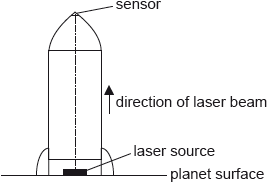| Date | November 2015 | Marks available | 2 | Reference code | 15N.3.HL.TZ0.15 |
| Level | Higher level | Paper | Paper 3 | Time zone | Time zone 0 |
| Command term | Discuss | Question number | 15 | Adapted from | N/A |
Question
This question is about general relativity.
A spacecraft is at rest on the surface of a distant planet. A laser beam is fired from the base
of the spacecraft to a sensor at the top of the spacecraft.

The spacecraft has a height of 112 m. The laser beam emitted from the source has a frequency of \(4.52 \times {10^{14}}{\text{ Hz}}\) and the sensor detects a shift in the frequency of the laser beam of 3.20 Hz.
Show that the gravitational field strength at the surface of the planet is about \({\text{5.7 N}}\,{\text{k}}{{\text{g}}^{ - 1}}\).
Discuss the shift in frequency of the laser beam.
The spacecraft leaves the planet with an acceleration of \({\text{5.7 m}}\,{{\text{s}}^{ - 2}}\). The same experiment is carried out by firing the laser beam from the base of the spacecraft to the sensor at the top of the spacecraft. Compare the shift in frequency of the laser beam with that detected in (a).
Markscheme
\(\frac{{3.20}}{{4.52 \times {{10}^{14}}}} = \frac{{g \times 112}}{{{c^2}}}\);
\(g = 5.69{\text{ (N}}\,{\text{k}}{{\text{g}}^{ - 1}})\); (needs to show three significant figures)
as photon moves away from the surface of the planet it gains gravitational potential energy;
\(E = hf\) the frequency has become lower (to compensate for this change);
the equivalence principle states that it is impossible to distinguish between an accelerating reference frame and a gravitational field;
therefore the frequency observed will be the same;
Accept combined effect if spacecraft still in the gravitational field.
Examiners report
Part (a)(i) and (b) were done well. Discussion about the shift in frequency in (a)(ii) was difficult as many candidates did not mention potential energy or other equivalents in the discussion.
Part (a)(i) and (b) were done well. Discussion about the shift in frequency in (a)(ii) was difficult as many candidates did not mention potential energy or other equivalents in the discussion.
Part (a)(i) and (b) were done well. Discussion about the shift in frequency in (a)(ii) was difficult as many candidates did not mention potential energy or other equivalents in the discussion.

